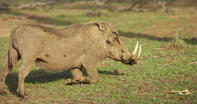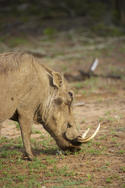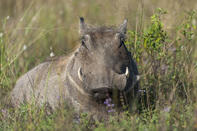Well Equipped
Warthogs are well equipped for their dietary habits. They have large, flattened molars and a modified jaw articulation perfect for grinding grass, in summer, and the harder bulbs, tubers and rhizomes unearthed during the dry season.

The head is flat and downward-facing terminating in the rounded cartilage snout that encloses the nostrils and is hardened on the upper side. This acts like a shovel to dig for tasty tit-bits up to 10-15 cm deep under even hard earth.
The warthog’s short neck gives leverage to the spade-like head when the warthog is grovelling. To further improve this action, warthogs often kneel down on their front ‘elbows’, carpal joints of the wrist, which are calloused from birth for this reason.
Digestive Tract

Warthogs are hind-gut fermenters. Where antelope process their food in a complex 4-chambered stomach, this ungulate or hoofed animal has only one stomach into which it piles relatively coarse-textured plant material.
The transit time through its stomach is faster than in ruminants that must first refine their food by chewing the cud. A warthog’s meal is only subjected to the micro-bacteria that can break down the cellulose of plant cell-walls towards the end of its digestive process - in ruminants this takes place first to ensure the thorough digestion of food.
The result is that a warthog defecates fortuitously and its dung has larger bundles than the pellets produced by antelope. It also comprises a material that is still fairly coarse textured.
The advantage of this ‘less-effective’ type of digestion is that they can put larger amounts of food through their bodies relatively quickly and as a result extract adequate nutrients at harder, dry times of the year. To facilitate their digestive systems, warthogs feed selectively choosing more nutritious plants and parts of plants. They are also exceptionally water-dependent and must drink daily.
Peculiar Taste

Warthogs have some peculiar eating habits. They exhibit osteophagia - the chewing of bones, geophagia -the chewing of soil and coprophagia - the consumption of faeces. They chew bones and soil to supplement nutrients that may be deficient in their usual diets. The young consume the adults' dung to colonize their guts with useful digestive micro-bacteria.
They also ingest dung to reprocess plant material that has not necessarily been completely digested the first time around due to their ‘poor’ hind-gut digestive system.
There are records of warthogs eating carrion, which may be attributed to the omnivorous habits of the pig family generally although it is unclear whether warthogs actually eat meat off carcasses or merely the stomach contents of herbivores typically discarded by predators.
By Megan Emmett